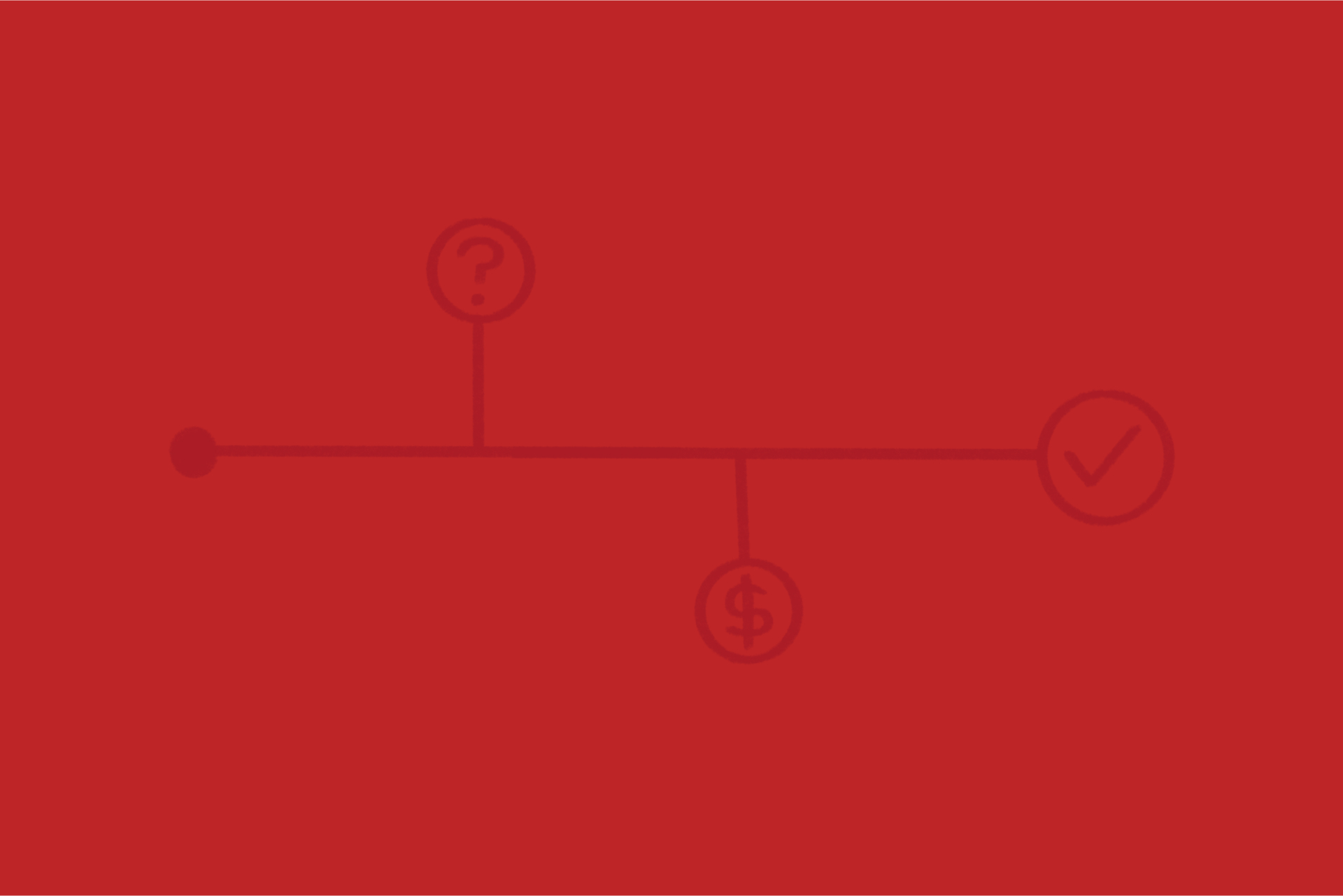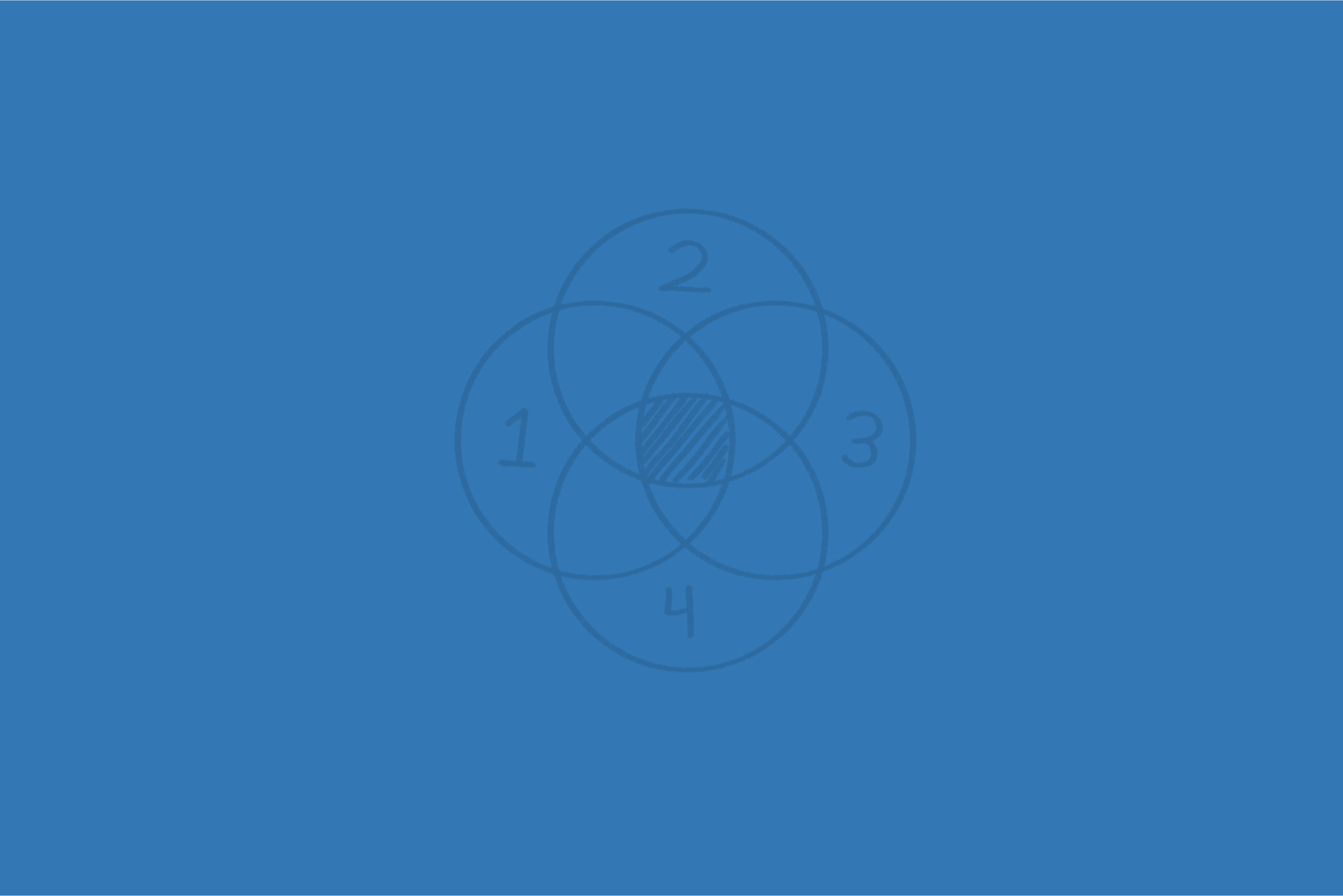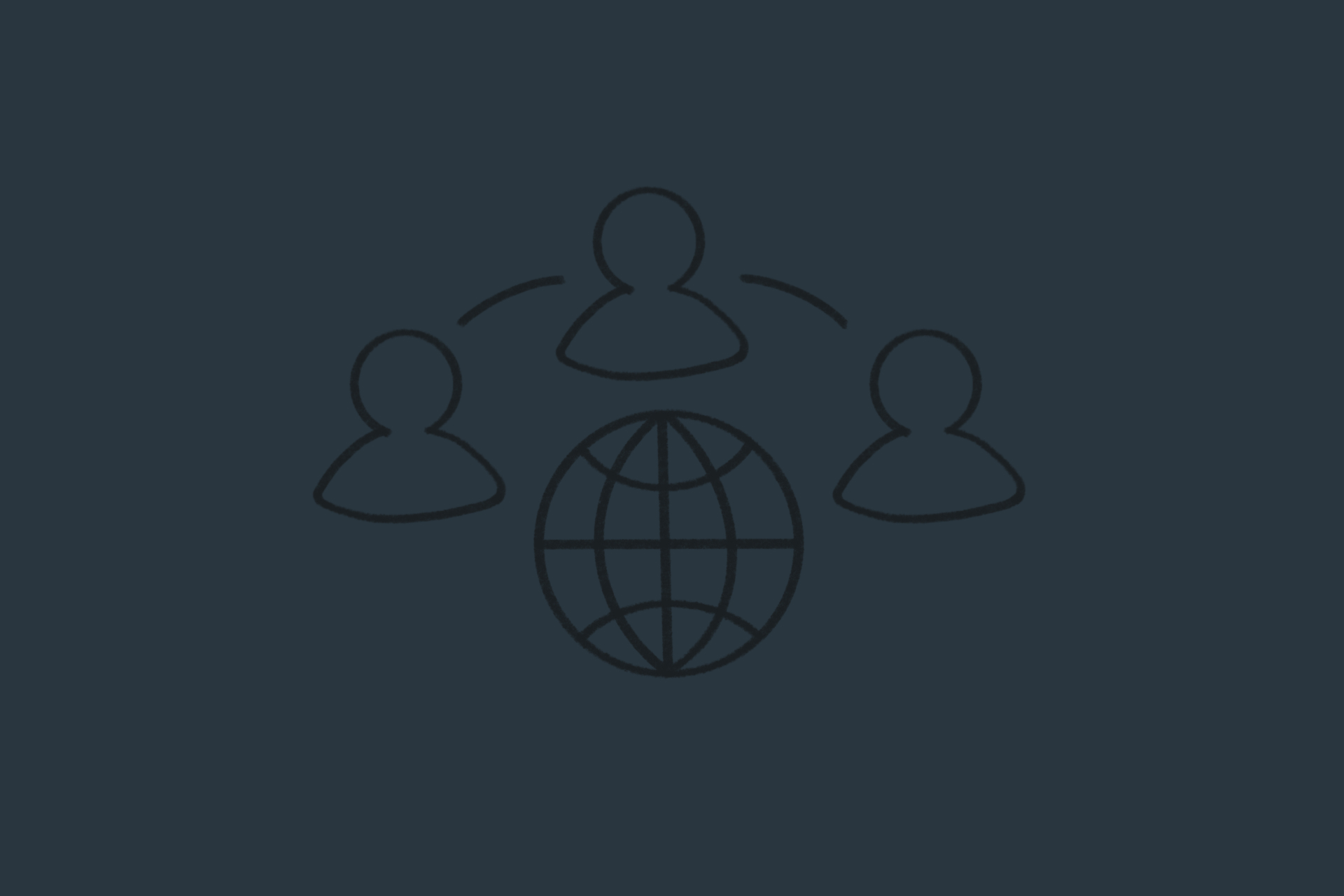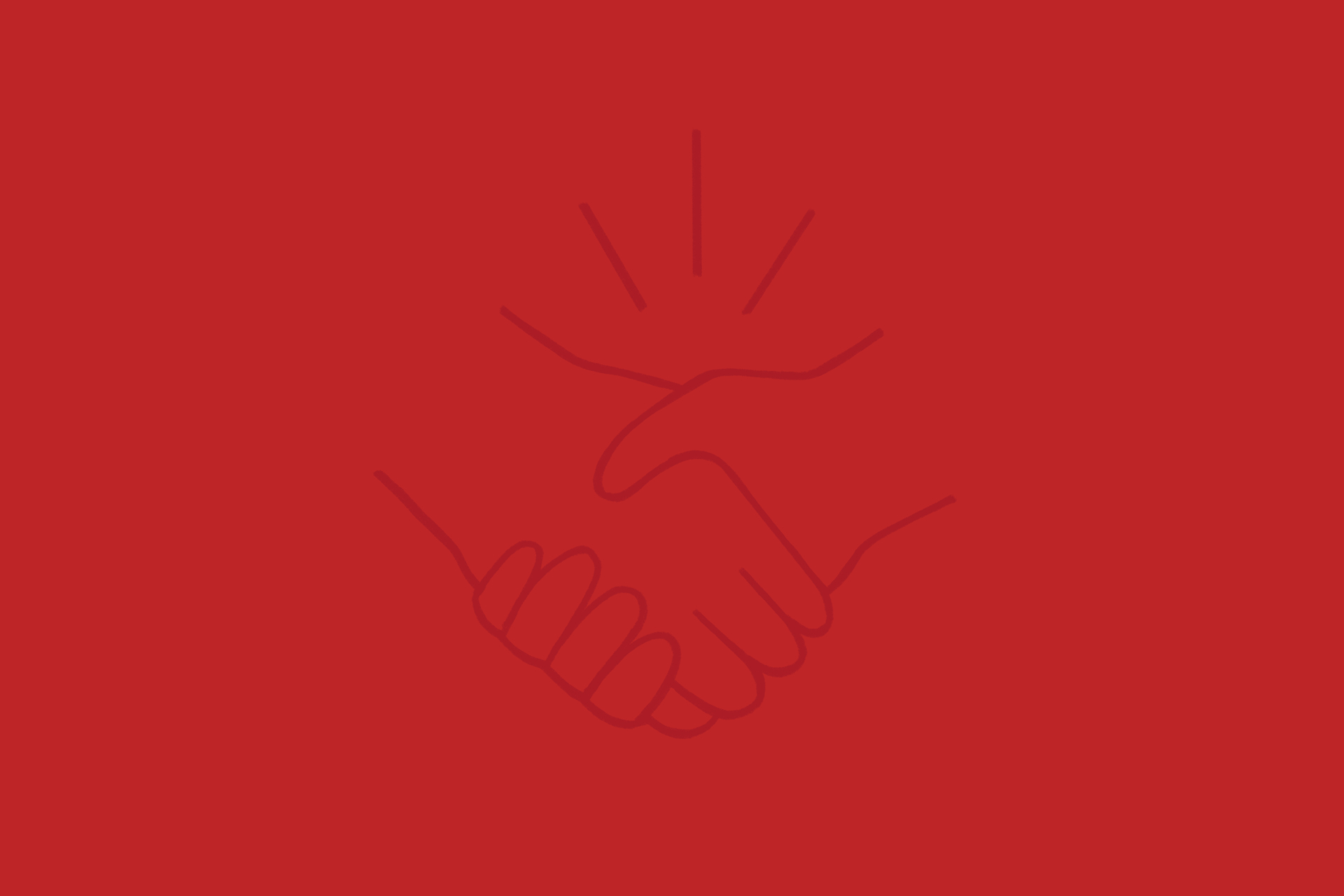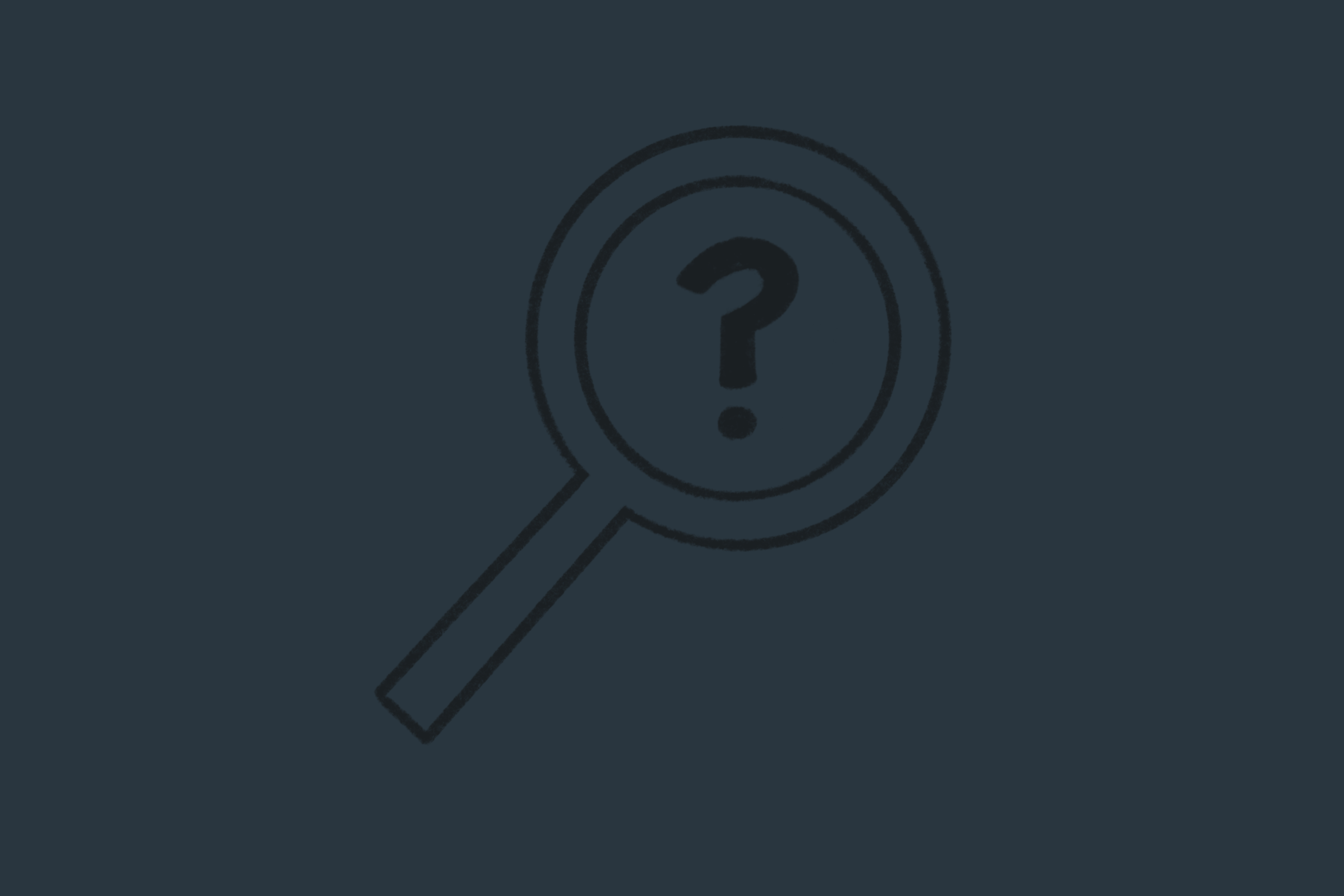Episode Summary
Our team dives into how well your organization embraces design, known as your “design maturity.” Visual Logic partner Andy Van Fleet is joined with Director of UX Design Nick Bray to share what organizations at varying levels of design maturity can look like—comparing small businesses all the way to innovative industry leaders.
The 7 Levels of Design Maturity
To discover more about your organization’s Design Maturity, review the following descriptions of each level and self-assess. Need more help? We would love to work with you to create a formalized assessment and action plan for strategic design growth.
1. No Formal Design
2. Pollinator
Few designers, siloed across departments, lack of design leadership
3. Ad Hoc
Designers collaborate across departments and may share design styles, lack of design leadership and structure around the way they’re organized
4. Federated / Distributed
Designers aim to be consistent with each other, still lack direction and expectation from leadership
5. Centralized
Closely resembles that of an agency model, designers reside under one roof and operate together as a collaborative team, design leadership begins to form
6. Hybrid
Combination of Federated and Centralized, formalized central hub for UX design within the organization for foundational support, while designers are staffed on programs or products
7. Hybrid+
Visionaries, obsessed with all experiences, from user experiences to employee experiences and beyond. They look at human-centered design as a way to solve all problems–internal and external to the company.
Transcript
[00:00:00] Andy: In Today’s episode of humans. First, we are gonna talk about the design maturity within an organization. And today’s guest is Nick Bray, UX design director at visual logic, has been doing user experience design in a wide variety of different formats for the last 15 years.
Nick, welcome to the show.
[00:00:27] Nick: Thank you excited to be here.
[00:00:29] Andy: Yeah Today’s, topic’s gonna be super interesting I think because design maturity within an organization is something that’s relatively new to this space in UX thinking and human-centered design. So when we talk about humans first, this really gets to the essence of a wide variety of different types of, organizational design, product design and, and how do you have design maturity within an organization that kind of hits on all these different aspects? So I think maybe just to kick things off, what would you say Nick is your definition of design maturity?
[00:01:11] Nick: Yeah. So to me, design maturity is made up of a lot of different things, but one thing that, resonates with me is a company’s ability to start seeing, The human need, not just the, a business gap, but the human need and their behaviors and the way that they feel and think about things over the technical, types of things that we produce or the hardware. So putting the person over product, which isn’t the way that we’ve always done things right, from the industrial revolution nine, we’ve built these types of products and, and people come to them. There hasn’t always been a lot of options. So, if you build it, they will come type of thinking. And that’s just not the case anymore. So to me, design maturity is about measuring an organization’s ability to be focused on the human and adaptive to their needs.
[00:02:00] Andy: That’s a great description. I think before the show we were talking about this journey, of the industrial revolution then to the information age, which was, I would say. Nineties into 2010. There’s no real distinct cutoff there, but, in some of the models that we’ve seen, you go from the information age to now the age of the customer.
So from 2010 and into today, really that focus on the end user and the customer has become paramount. And it’s super important to get this right. That’s what we’re talking about today is this design maturity. Just demystifying that to a certain degree, there are levels that we’ll walk through about the different levels of design maturity, which there’s five or six of those.
And then talk about the design team structure within each one of those. And then maybe reference to some of the companies that are doing, these different levels of maturity. We’ll walk through some of those as well, but for context, we can just do a high level overview of what these, design maturity levels are and name those for the audience.
Because I know for me about, five years ago, this became a new concept as far as understanding that it’s not just a matter of putting a UX designer into an organization that’s the infancy thinking of if a company’s gonna put a UX designer into the organization. That’s a start, but that’s a start that a lot of companies got a number of years ago and have done that maybe 5, 10, 15 years ago. And then they have really grown their practice and done really well with that so I will walk through some of those levels and talk about the different structures of the teams within each of one of those levels. But I would say, for us, as we made that transition, from doing product work for user experience to helping organizations really widely apply human-centered design across the organization that’s when we really had, I think that aha moment of like, where does design live in an organization and how broadly can we apply human-centered design in the organization.
[00:04:02] Nick: Yeah. That’s great. And I’d love to walk through those. I wanted to go back real quick, you mentioned something about the information age and then moving to the age of the customer. And I might be wrong on this, but I’m of the mindset that, we have so much information, that we’re collecting, and oftentimes you hear people say, Information is knowledge or information is power and, yeah, that’s true, but yet we’re still experiencing so many bad well experiences, right?
so we’re collecting all this information and then what are we doing? Are we being effective with it? And that’s where I think this shift into thinking about the human first is important because we can collect a lot of data points about our user base, but if we’re not able to map that to behavior and motivation and understand the way that they think about their ecosystem, we’re still gonna fall way short on delivering experiences. so that’s kind of another aspect of design maturity or something you look at is what are you actually doing with the information? How are you storing it so that it’s usable. How are you able to make decisions off that? going into the different levels, we’ve had a lot of experience working with clients of all different sizes, and different domains and been able to observe the way that they’re structured and, the way they work. In addition to a lot of research, that’s out there about this. So the scale that we think about and that we use goes from zero to five. It looks like there’s six levels, but there’s actually seven because we break #3 into two. But it starts with, zero being no design and you could argue that nobody has no design but, relative to what our expectations are about delivering good experiences, I think that category still exist. then it goes to level one, which we call, pollinators. That level is really young in the maturity. So we’re talking, you might have a couple designers within the organization. They might not have formal design leadership. they might not even know each other exist within the organization. they might be hired for two completely different products, and they’re just doing their best to, try to get people excited about, design heuristics or whatever it might be.
[00:06:01] Andy: Just for context, there might be a couple of designers in that organization and that organization could be a wide variety of, employees big, so it might be a hundred employees or it could be a thousand employees. We’ve seen a lot of different ratios from two UX designers, supporting either a small, medium or large organization.
[00:06:20] Nick: Right, absolutely. When I say a couple, I think obviously the bigger the organization, the worse the ratio gets there. But even on small organizations, they’re not able to be that productive because, it’s not just that they’re in the organization. It’s also what point in the product development process are they actually included?
Do they start at project kickoff? Are they before project kickoff? Are they listening to strategy meetings about why this might be beneficial or bring value to the company so that they can start to wrap their head around that? Or are they brought in after the architect said, here’s how everything’s going to technically work, so just go ahead and do the best you can. So there’s a lot of different factors in that.
[00:06:56] Andy: So those are pollinators at level one.
[00:06:58] Nick: Yeah and then level two is ad hoc. This is getting a little bit more organized. you might not have any formal design leadership skill, they might have some knowledge that each other exists and they might trade ideas back and forth. Nothing like a design system, but "Hey, Component worked for me, or I solve this problem in this way." Very much ad hoc, right? Like there’s not a ton of structure around the way that they’re organized and work together,
[00:07:20] Andy: but they’re sharing assets and they’re communicating ad hoc, like you said.
[00:07:24] Nick: yeah, they’re starting to get better at it. They’re starting to see that, oh, there’s other people like me if this company, and maybe if we put ourselves together, we can gain some momentum.
[00:07:32] Andy: Between levels one and two, can you map like an experience that the listeners could relate to that would feel like this organization probably had a couple of designers and ended up putting out this product or this experience.
[00:07:46] Nick: Yeah. So I’ve spent the last almost six years in the DoD space and seeing some products out there. You can tell that there was some attempts made to fit to some human factors or ergonomic level types of, human centered design, but that they hit what you would call the baseline standard for that.
So was the button wide enough for most people’s thumb or those types of things. And so there’s people that are trying to do their best to meet a standard, but much beyond that has not been thought through.
[00:08:19] Andy: Yeah, that’s a great point. And then I think as you’re describing it, what resonates with me is you have, I think public transportation when you go to buy a train ticket or, whatever type of ticket you might be trying to buy. And there’s that panic moment because the system has been designed in a way that there was a little bit of design thinking into it, but it was 90% engineering and it leaves the end user feeling kind of fraught with a little bit nervousness. Also you’ve gotta. This job done. You’ve got kids with you or whatever it might be. So it’s not meeting the end user where they need to be met. And so it feels like that might be a great example of, their teams maybe had designers that had good intentions, but were not able to successfully execute because they just didn’t have the, bandwidth to be able to pull off a good design.
[00:09:05] Nick: yeah it’s funny, like when you hear about. You don’t really think of, getting on a bus or something like that as a massive design achievement, but, some subsidies are seeking to do it well. And then you hear about how great of an experience they’ve made their city transportation and, it’s exciting. But every time that I travel, I’m always thinking, "am I gonna have to figure this all out on myself? Or like how much of a nightmare is this gonna be for me to get from point a in the city to point B?"
[00:09:34] Andy: Yeah, great point.
[00:09:35] Nick: So that’s ad hoc. So level three, we talk about two different ways.
There’s kinda like this federated model. And I think it’s maybe something that’s important to say here is every single one of these, labels that we’re calling these maturity levels are really structured around how the organization is put together. So thinking about it, literally, what is the structure of the design organization?
So level three, being federated or three a, I should say, being federated, which is, you have people distributed across the organization and some people call this distributed model. there’s no real roll up to design leadership still, but they are cognizant that, others are there. They are working, to document things, to pull together lightweight design systems.
They are thinking about process, and they are trying to be consistent across brand. They might be doing all of that without expectation from leadership, but they themselves are doing it and, they’re trying to piece that all together. Then there’s level three B centralized, which is really getting closer to an agency model. All those people are pulled together under one UX design roof, and, operate a little bit in each so , this designer works this project for six months and this one works another project for three months in there. You actually do start to see some leadership formed.
It might be a principal or a senior most leader designer that kind of manages the resourcing of that, or you actually would potentially have a UX manager in there, doing that type of work. So we look at those both about the same maturity level, but different organizational implementation.
[00:11:07] Andy: So what would be an example of a company out there that you can think of that would fall into one of those two categories?
[00:11:12] Nick: Well if you think about the automotive world Chevy and Ford five, maybe 10 years ago. They’ve obviously made tons of improvements over the last few years, but if you think about maybe 10 years ago, those two companies weren’t studying the standard for the interior design of cars, right. Other companies were above and beyond. So while there was still intentional design within those spaces, those interiors of the trucks or the cars that you would get into, they just didn’t execute quite as well as what some other brands were doing. It was noticeable. But since then, of course, I think they’ve noticed too. Right and they’ve done much better over the last few years
[00:11:50] Andy: yeah, that’s a great point.
[00:11:52] Nick: so four and five are both called hybrid. We just call one hybrid plus, but that’s really when you combine federated and centralized together. And now you do have a centralized hub the foundation of design of UX design or human center design within an organization.
And then you also have, embedded designers within, flagship product teams, or longlasting contract teams. They’re there to be the UX designer with the most domain expert or, SME level expertise within that product. Then they might have support UX designers that kind of like ebb and flow within them, but they’re stationed there. that’s their domain. And then the centralized hub of that hybrid model is really around design ops, potentially owning the design system, and the gates for that, any documentation and processes that need to go along with it as well as really being, the advocates for human-centered design with all the leadership in that organization.
They’d be trying to network there making sure that human centered design is an equal seat to the table in a lot of these different area.
[00:12:52] Andy: So some of those companies that fall into hybrid and hybrid plus would be like Disney Tesla, Airbnb. They’re thinking about design completely differently than just a few designers working on this product. explain, how they’ve thought about it and expanded upon.
They’re thinking about how design can be a powerful tool within an organization because they do get it right. Tesla has done a great job getting it right at the interface level, but I think they use design as a powerful tool beyond just screen designs.
[00:13:21] Nick: The companies in those especially hybrid plus category, I would say are obsessed about the experience and in order to be obsessed about the experience that deliver to users, you also have to be inwardly obsessed about the experience you deliver to your employees and Disney would be an example of that. Love or hate that place, to me, it’s a lot of people, right? But the employees seem genuinely happy when you’re there. And they’ve really thought about how they take care of their own so that they can take care of the people that are there visiting the parks. And sure they’ve got great designers. The buildings are crazy. It’s a magical place, but they’ve thought through all these nuanced levels of experience, inwardly and externally, and that to me is what, somebody at the level five is doing wildly different. they’re able to create better experiences because they’ve turned the process inward to themselves, use that on their own business practices and figure out how they’re gonna operate. And then they’re able to create better services, products, all that sort of stuff.
[00:14:18] Andy: And I like that you used the word obsessed because I think that’s a hundred percent accurate, which is they are endlessly obsessed about designing for all experiences.
[00:14:26] Nick: Yeah. And Disney’s obviously a huge one. Maybe even Airbnbs up there. Even companies in the last couple years that have really had an opportunity to shine when we had COVID going on. And more people are working from home and we’re missing our whiteboards and you’ve got mural and all that. They’re really competitive about who can deliver the next best experience, through that process.
[00:14:46] Andy: So to maybe recap the different levels, and maybe just quickly put like a ratio to some of these. So, one designer to X number of developers or whatever kind of ratio that you would use so that the listers can envision what exactly this would feel like in their organizations.
[00:15:04] Nick: So I think that and. I don’t know. Was it Adobe, Andy? I think it was Adobe that, yeah, they put out the number of like one to eight.
[00:15:11] Andy: so that’s one UX designer to eight developers.
[00:15:13] Nick: Right. Correct.
[00:15:15] Andy: And that was a pretty aggressive number. I mean, that’s a good ratio for making sure that products are highly usable and well designed.
[00:15:21] Nick: right. And I think one company we actually talked to had like one to seven, which was amazing. I think oftentimes, Setting our expectations at like one to 12, one to 15, from a budget standpoint is probably a little bit more reasonable, but all that to say, if you’re at one to a hundred, there’s a problem, right?
You don’t have enough bandwidth to help the amount of production that’s going on, to provide them user insights, to make good design decisions at every point in the process.
[00:15:48] Andy: While it’s not a, scientific way for us to evaluate companies, it’s something that we do is to look at LinkedIn at a company and see how many UX designers does a company have. And then how many developers systems engineers or, software developers, do they have too, and then kind of do a quick number, a quick thumb in the air to see like, where are they at?
So it gives us a competitive landscape there. So I guess just recap real quickly, the different levels. And then we’ll move on to the next, topic here related to design maturity.
[00:16:16] Nick: yeah, so real quick, it would be zero is none. We have one, the pollinators, just a couple people at the organization probably don’t know about each other. Two is ad hoc, starting to become a little bit more organized there’s awareness that they, that there’s others at the company and maybe they’re sharing ideas.
Level three is split between federated and centralized. So distributed model versus agency model within, an organization, but still, probably too small, to support the entire organization. And then you have hybrid and then hybrid plus, and those are the visionaries or the, I guess the people who were obsessed, with experience.
[00:16:51] Andy: It’d be very interesting to know, like the ratios that Disney and Tesla and Airbnb have as far as who’s doing human centered design as compared to the rest of the organization.
[00:16:59] Nick: That ratio gets hard to measure, I think at hybrid plus, because culturally they’re different. You have people that aren’t actual position of UX designer or human center designer or service designer. Doing design thinking in their job. So it’s permeated the company it’s their engineers are actually thinking, about users first and asking user based questions versus technical questions first. And so that is a culture change. And those people don’t have to be expert designers, but they understand the right questions to ask first, to get to better design decisions.
[00:17:30] Andy: Absolutely. Yeah. And that brings up a point this morning. I just saw a large agricultural company, in the Midwest here just hired a chief people experience officer. Yep. And I think that’s exactly what we’re talking about, which is, it’s hard to measure that as it’s not a UX designer, but it’s an experience role that impacts the organization.
[00:17:49] Nick: Yeah and will ultimately impact the end product that goes out too. Happy people, are gonna do better at their jobs. They’re gonna produce better experiences going out.
[00:17:56] Andy: Absolutely. So I think it’s been a lot of great information that’s been shared, but tangibly, what would be something that would be interesting to the listeners is like what tools and methods can be used to measure an organizations’ design maturity level and in what ways can a person who’s listening, be able to say, okay, this is a way for me to be able to take a few questions or a questionnaire, or, these other tools that you may have that we’ve either used ourselves or that we’ve found online, to be able to help somebody measure the organization, design maturity for that particular individual’s work.
[00:18:29] Nick: Yeah There certainly are tools out there that you could, give away email, phone number, all that sort of stuff to go through and fill out. I’m sure they will help you. I think the way that kind of the most basic way you can think about it. And we talked about some of this is, first ask the question, how many designers do you actually have in the organization?
and not just that, what’s the highest level kind of human centered designer that you have in that organization. Are they at the individual contributor level? Do you have management? So those would be things to consider. This is a little bit of a qualitative, method, but how often are people actually asking about the user? That’s a dead giveaway. When working with some customers in the past, you can watch it over a couple years, the transition, from asking really technical based questions all the time in delivery and budget based questions to, is that what the persona or this target user or whatever would actually want.
And you’re like, yes, that’s it. It’s like it’s qualitatively starts to notice that type of thing. It’s hard to measure that and then I would say another one is how much budget is designated to an upfront understanding before a project really gets underway.
You can tell how the company’s gonna spend their money is gonna be pretty indicative of how much they’re accepting of that type of thinking.
[00:19:44] Andy: And I think that’s really important just to stop there for a second. What you just said really would help an organization because a lot of money’s wasted on products that are designed without input from a UX team or from a design team that really understands what the user’s experience should be like or what their current bad experience is and how are gonna change that.
We’ve seen it time and time. Again, a lot of companies that just get started on what they think is the best idea going forward, and don’t have the background and the know. Really from the field or, from the end users to understand like really what needs to change and how do we design for that?
[00:20:20] Nick: Yeah absolutely.
[00:20:22] Andy: And that’s a maturity going from, we’re just gonna get started to let’s stop and ask a bunch of questions related to our end users. And then get started.
[00:20:30] Nick: I could probably go on forever on all these, but another way that you might be able to observe within a company is just how they collect. Customer support feedback, how they collect information from their users, then how is it stored? Is it stored in a way that they intentionally make it accessible so that people could make product decisions off it?
Is it fragmented? Is it so those would be things that if I was internal to the company, wondering what our design maturity is, I’d be thinking about those types of things.
And then eventually, you have to try to solve those, but those would be some of the upfront questions I would ask.
And then you’d get a gut feel from maybe where you sit,
[00:21:04] Andy: I think too, measuring your own design maturity is one thing, but then also we talked about this, but the competitive landscape. So if you end up being a three and then you do a competitive analysis and everybody else is a two or a one, that’s great. That’s good information to know, but if you measure yourself at a three and everybody else is at a four there’s work to be done.
[00:21:25] Nick: Yes, absolutely. And I think it’s worth being said that zero to five is the scale, but, the industry and domain, the context that your business, resides within is gonna have some limitations in terms of what you can do.
And I think, we talked about. Early on in the department of defense, we acknowledge that, there’s actually limitations there culturally on the, DoD side that doesn’t allow, the organizations that build products for them to achieve visionary levels of human center design.
Not yet. Anyway, we’re hoping that we’re hoping that changes. But there’s a deeply embedded cultural thing. That’s preventing that from moving fast, way slower than the commercial side of the world. In, terms of the way that they’re growing design maturity. And so we acknowledge that fully and know that, we might have to be satisfied with lower levels of maturity because a level three or a level two there, today is almost equivalent to a four or five and they’re in the Pentagon’s eyes, that’s just how that works.
[00:22:19] Andy: No, that’s a great point, and I think that in the show notes we’ll include the information related to the different levels. A little bit deeper dive about the levels, and then I think a kind of a rule of thumb ratios is something we’ll put out there too, of what we’ve heard with like the Adobe one to eight, we’ve heard some one to seven, but , in reality, there’s, one to 15 might get X, Y, and Z done. We’ll put something about that information in the show notes. So people have more context around that because it is a very broad topic.
When you talk about design maturity in an organization, and I think it will open up a lot of people’s eyes as to UX is not just an activity that gets applied to a product. It has wide variety of different applications throughout an organization. And there’s a lot of great companies out there applying, design, thinking across the organization products, employee experience, and they’re doing it really well.
So Nick, thank you for your insights and your wisdom. Always great to hear from what you’re seeing in the field and, appreciate everything that you have shared with us today.
[00:23:21] Nick: Really appreciate the opportunity to do this. It was fun.
